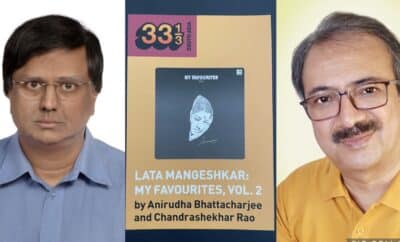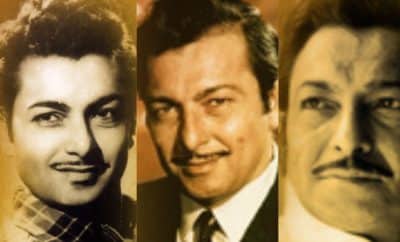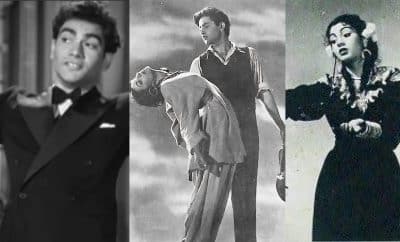Legends
Lata Mangeshkar – The Musical Milestones in Her Magnificent Career
Lata Mangeshkar – apparently only two words, but effectively they encompass in themselves a whole world of music! Lata Mangeshkar – the final authority in playback singing! Lata Mangeshkar – the Everest in the arena of playback singing, which many aim to reach, but can hardly make it only upto the basecamp!
She entered the world of cinema as an adolescent girl, and after a lot of rejections and an uphill battle in the industry dominated by many established senior singers, she paved a mega highway that took her to the highest position. She built the golden edifice of her songs which is more splendid than the Taj Mahal. She became the brightest guiding start for those who followed.
Ever wondered what distinguishes her from others? The God-gifted divine voice, professionalism and expeditious proficient delivery were of course the main factors. But that’s not all. She would take the composers by surprise in her rendition, by amplifying what the composers expected. She had an astounding sense of lay (tempo or meter). While there are many singers whose notes come out perfectly, unlike most others, she had an exceptional capability to subtly yet amazingly fill in the gap between two notes. One is sure to notice this, particularly after hearing her songs in someone else’s voice. Some say that her rendition is less emotive as compared to Asha Bhosle or Geeta Dutt. But isn’t it true that all her notes in a particular song would come out drenched in the emotion in the song? Even after using all the plaudits and platitudes, there still remains something to be said about her. And that’s what distinguishes her from all others!
Let us glance through some musical milestones on the highway of her prodigious singing career spanning across more than seven decades:
1. First released film song
She lost her father in 1942, when she was barely thirteen. Even at that tender age, she sensed the responsibility that her father’s demise had shouldered her with – the responsibility to earn bread and butter for her mother and four younger siblings. In no time after the mishap, she started looking for the means of livelihood. The eminent producer, director and actor Master Vinayak (Vinayak Karnataki, the father of the popular actress of later years, Nanda), who had recently joined the banner Navyug Pictures, extended a helping hand out of compassion. She was auditioned by the composer Datta Davjekar who had recently joined the company. Being quite impressed with her singing, he strongly recommended her to Master Vinayak.
Lata Mangeshkar thus became a salaried employee of the film company and got a small role in the Marathi film Pahili Mangalaagaur (1942). She also recorded a song for the film “Natali chaitrachi navalai” (the astonishing bounties of spring have decorated the surroundings). This was a duet with the actress – singer Snehaprabha Pradhan.
This was however her first released film song, not the first ever film song. She had recorded her first film song “Nachu ya gade, khelu ya saari” (let’s all play and dance) for Vasant Joglekar’s Marathi film Kiti Hasaal (circa 1941). However, the song was dropped from the film.
2. First Hindi song (for a Marathi film)
Very soon after Pahili Mangalaagaur, Master Vinayak left Navyug Pictures due to some feud and shifted his base to Kolhapur, where he started his own film company Prafulla Pictures. Lata Mangeshkar also relocated to Kolhapur with her family and started working under Master Vinayak’s new banner. She got a chance to record her first Hindi song for Prafulla Pictures’ Marathi film Gajaabhaau (1944) – “Hindustaan ke logon, ab toh mujhko pehchaano” – which was composed by Datta Davjekar. Unfortunately, the video or even the audio of the song is not available on the internet.
3. First Hindi song (for a Hindi film)
Prafull Pictures produced Badi Maa (1945) which starred Noor Jehan in the lead role. Lata Mangeshkar and Asha Bhosle had played small roles in the film alongside Noor Jehan. Lata Mangeshkar also sang a song for the film, “Maata tere charnon mein guzar jaaye umariyaa”, with the actor – singer Ishwarlal. This was the first Hindi song that Lata Mangeshkar recorded for a Hindi film.
Lata Mangeshkar had been fondly listening to Noor Jehan’s songs before and she was very happy to get her glimpses on the sets of Badi Maa. She would keenly but silently observe her way of speaking, her acting and her singing. Once, on the sets, Master Vinayak introduced Lata Mangeshkar to Noor Jehan and asked her to sing a few lines. Noor Jehan was thoroughly impressed with young Lata’s singing skills and remarked that the girl would earn a big name for herself in future. The destiny was probably speaking through her words!
The song was filmed on Lata Mangeshkar herself amongst others, and hence wasn’t a playback technically.
4. First Hindi playback
Sometime in 1945, Master Vinayak decided to shift his base to Mumbai. Lata Mangeshkar also shifted to Mumbai alongwith the other crew members. While she was managing to earn some money by doing small roles and singing songs for Prafulla Pictures’ films, the lady luck was again in a mood to test her.
Master Vinayak passed away in 1947 and Prafulla Pictures came to an end. Lata Mangeshkar found herself in the same difficult situation as 1942 – no money and many mouths to feed. She was not paid for six months as Prafulla Pictures wasn’t doing well. While she was in a shock and trying to figure out the way forward, one of her neighbours and a cameraman in Prafulla Pictures, Papa Bulbule, came to her rescue. She took her to a composer named Harishchandra Bali who was looking for a new singer. She recorded a song for his film ‘Blind Love’, which was eventually shelved. While she was recording for Harishchandra Bali, a supplier of extras for films asked her to visit Filmistan studio the next day, where Master Ghulam Haider wanted to meet her. Master Ghulam Haider asked her to sing something, but she ended up singing off key. Master Ghulam Haider could make out that she was under pressure and asked her to see him again in a couple of days. The next time she met him, the expert musician in him immediately noticed her striking acumen and offered her to sing the heroine’s songs for Shaheed (1948) that was in making then. However, the producer Shashadhar Mukherji flatly rejected her voice terming it as ‘too thin’. Master Gulam Haider did not however give up and offered her songs in Bombay Talkies’ Majboor, including the famous one, “Dil mera toda, o mujhe kahin ka na chhoda tere pyaar ne”. The film and its songs were released in 1948.
Meanwhile, she had recorded a song for Vasant Joglekar’s film Aap Ki Seva Mein (1947) – “Paa laagoon kar jori re” – which was filmed on the famous Kathak dancer Rohini Bhate. It became her first Hindi playback song. Datta Davjekar was the composer of the soundtrack Thus Datta Davjekar was associated with the three initial milestones of Lata Mangeshkar’s career –her recruitment in Master Vinayak’s Navyug Pictures in 1942, her first Hindi song for a Marathi film in 1943, and her first Hindi playback song.
5. First song that gave her the identity as a playback singer
Singing for Master Gulam Haider was a huge break for Lata Mangeshkar. Consequently, a few other music directors like Anil Biswas and Khemchand Prakash noticed her flair. Though she started getting the playback assignments, she was still struggling to create her identity amidst many settled and struggling singers.
And then came the song– “Aayega aanewaala” from Mahal (1949). The song says – one who is destined to arrive will certainly arrive. Was it just a coincidence that the song with these words announced the arrival of the empress-to-be on the firmament of Hindi film music?
Composed by Khemchand Prakash, penned by Nakshab and picturised on Madhubala accompanied by Ashok Kumar, the song is probably the first haunting song in Hindi films. The record of the song had the name ‘Kamini’ (Madhubala’s name in the film) as the name of the singer. When the song was telecast on radio, the radio stations were flooded with numerous enquiries asking for the name of the new singer; and the radio stations had to then find out and announce that the song was sung by Lata Mangeshkar. And thus, the commencement of the ‘Lata Era’ was announced!
On the screen, the hero hears someone singing at a distance and the voice approaches him gradually. As the recording technology was not so advanced then, in order to achieve this effect, Lata Mangeshkar had to walk upto the mic from a distance singing the initial verse. The song did not attain the finality in one take, and Lata Mangeshkar kept on walking from a distance to the mic singing the the initial verse over and over again. No wonder, the fine piece of art that emerged out of this patience, commitment and dedication became a major hit. Alas! Khemchand Prakash passed away soon after the song was released and could not see the grand success his composition had achieved.
Can you imagine that the song was recorded on the set where the film was being shot; and not in a state-of-the-art recording studio?
Raj Kapoor’s ‘Barsaat’ released in the same year was the first film to display the playback singers’ names on the records as well as on the screen. This happened only due to Lata Mangeshkar’s perseverant insistence. The songs from this film too contributed a lot to her fame.
6. First Filmfare award
Lata Mangeshkar’s career took off soon after these songs were released, and towards the mid-1950s, she became the leading female playback singer and a household name in India. However, before 1959, there was no Filmfare award for playback singers. It was announced for the first time in 1959, and she won it for “Aaja re pardesi” from Madhumati (1958). (There were no separate awards for male and female playback singers then).
Salil Chowdhary had once said that the tiny-looking singer (Lata Mangeshkar) looked like a tall giant while singing. Wouldn’t she have surely looked like one, occupying the entire recording studio with her ethereal voice and aura while recording this song, in particular?
Again, Lata Mangeshkar was instrumental in making sure that Filmfare launch an award for playback singers. In 1957, the Filmfare award for best music was declared to the composer duo Shankar – Jaikishan for Chori Chori (1956). Jaikishan requested Lata Mangeshkar to sing “Rasik balma” from the film, on the stage during the award function. Lata Mangeshkar denied the request stating that she would not perform in a function that did not recognise the contribution of playback singers. Filmfare finally started the award for best playback singer, soon thereafter, in 1959.
7. First song recorded after severe illness
By the end of 1950s, Lata Mangeshkar had become the undisputed empress of the playback empire in Hindi cinema. In a matter of just a few years, she had swept away almost all the established female playback singers. The grudges and jealousy that her towering success would have invited are unimaginable!
In the early 1960s, someone poisoned her through food. The impact was so severe that she was bed ridden for several days, with no ability to move around or speak, let alone to sing. The main suspect was her cook, who ran away soon after the incidence, but the mystery as to made him do this remains unsolved.
Hindi cinema and the music lovers were thankfully not destined to lose the queen so soon, and she eventually recovered after a prolonged illness. This would have been no less than a national calamity for millions of music aficionados and together they would have prayed for her from their deepest core!
While she finally recovered and started getting the playback assignments again, her self-confidence had gone down. She therefore decided to record a song for Hemant Kumar, who was a good family friend and a fatherly figure to her. She had a confidence that he would help her if something went wrong. The song was “Kahin deep jale kahin dil” from Bees Saal Baad (1963). And the result was jaw-dropping – she had passed the test with flying colours! What’s more, she won the Filmfare award for the best playback singer for this song!
Though Filmfare awards may not be the perfect measure for an artiste’s skills or success (as the history has witnessed some surprising winners of these awards), it is notable that Lata Mangeshkar deservingly got for a Filmfare award for a song that she recorded after recovering from a prolonged illness.
Can you believe, she recorded the song with little self-confidence and a fear of going wrong? That’s what makes her stand out!
8. Last Filmfare award
After receiving a few Filmfare awards, Lata Mangeshkar announced that she would not accept any Filmfare award, in order to leave scope for other talented singers. The song for which she received the last Filmfare award in 1970 was “Aap mujhe achchhe lagne lage” composed by Laxmikant Pyarelal for Jeene Ki Raah (1969).
Later, Filmfare awarded her with Lifetime Achievement Award in 1994, with a Special Award in 1995 for “Didi tera devar deewana” from Hum Aapke Hain Kaun (1994) and another Special Award (golden trophy) in 2005.
9. Last film song
Hindi film music moulted its skin several times, once at the commencement of the golden era (the late 1940s), then after the end of the golden era of film music (after the 1970s) and then post the 1990s. Though the golden era is believed to have ended after the 1970s, melody still remained at the centre of film music until the end of 1990s. However, the avatar that the film music came up with after the last moulting wasn’t so pleasing – thanks to advancement of technology, increasing digitisation of music and changing choice of public marked by temporariness (of course, some exceptions are there!).
In the wake of this new avatar and her increasing age, Lata Mangeshkar started appearing in film music decreasingly post the 2010s. Even during the 2000s, she appeared sporadically in the soundtracks of some composers like Jatin – Lalit and A.R. Rahman.
Her last recorded film song is “Jeena kya hai, jaana maine” for the LGBT film Dunno Y2 – Life is a Moment (2015), which is a sequel of the 2010 film Dunno Y – Na Jaane Kyon. Lata Mangeshkar has also sung the female version of the title track of the 2010 film. The soundtracks of both these films are composed by Nikhil Kamath.
10. Last recorded song
After the mid-2000s, though Lata Mangeshkar reduced her work for films, she recorded songs for many private albums. Her notable private albums during this period are ‘Sarhadein: Music Beyond Boundaries’ (2011) – in which she sang a duet with Mehdi Hassan under the baton of Mayuresh Pai; a devotional album ‘Swami Samarth Maha Mantra’ (2012) – composed by Mayuresh Pai again – with which she launched her music label ‘LM Music’; a Marathi album ‘Kshan Amrutaache’ (2013) composed by Saleel Kulkarni; ‘Shurodhwani’ (2014) – a Bangla album composed by Mayuresh Pai, which included poetry by Salil Chowdhury; and A.R. Rahman’s private album ‘Raunaq’ (2014), in which she has sung one song.
The song “Saugandh mujhe is mitti ki” which Lata Mangeshkar recorded as a tribute to the Indian army under Mayuresh Pai’s music direction in 2019 became her last recorded song.
However, this was not her last recording. In 2021, she recorded a Shloka (verse) from Shree Raamraksha Stotra, with music by Mayuresh Pai. The recording is titled as “Shree Ramarpan”. Prime Minister Narendra Modi posted this on X (erstwhile Twitter) on 17th January 2024 as her last recording, in her remembrance and the advent of the then upcoming consecration ceremony of Shree Ram temple in Ayodhya.
These are just some shining milestones on the mega highway of her colossal career. Between any two of these milestones, there lie uncountable glittering musical gems, which make a travel on the highway of music never tiring and our life worth living!



